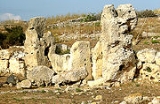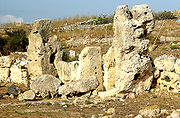
Grey Skorba phase
Encyclopedia
The Grey Skorba phase follows the Early Neolithic Għar Dalam phase (5200-4500 BCE) in Malta
's prehistory. It is marked by a distinctive grey pottery, without decoration. Other remains from the period include seashell
s, bone ornaments and implements, stone tools and number of sling stones possibly used for hunting. Flakes of obsidian and flint were found, probably imported from Sicily
. The Grey Skorba phase evolved into the Red Skorba phase (4400-4100 BCE).
 The prehistoric site at Skorba
The prehistoric site at Skorba
was first noted during the early years of the twentieth century. At the time, a conspicuous megalith
was recorded as a menhir
; however in 1937 Captain Charles Zammit, curator of archaeology, established the presence of other megaliths in the immediate vicinity and the site was fully excavated by David Trump between 1961-1963.
The importance of Skorba lies chiefly in the information that its artifacts provide about Maltese prehistory
.
Malta
Malta , officially known as the Republic of Malta , is a Southern European country consisting of an archipelago situated in the centre of the Mediterranean, south of Sicily, east of Tunisia and north of Libya, with Gibraltar to the west and Alexandria to the east.Malta covers just over in...
's prehistory. It is marked by a distinctive grey pottery, without decoration. Other remains from the period include seashell
Seashell
A seashell or sea shell, also known simply as a shell, is a hard, protective outer layer created by an animal that lives in the sea. The shell is part of the body of the animal. Empty seashells are often found washed up on beaches by beachcombers...
s, bone ornaments and implements, stone tools and number of sling stones possibly used for hunting. Flakes of obsidian and flint were found, probably imported from Sicily
Sicily
Sicily is a region of Italy, and is the largest island in the Mediterranean Sea. Along with the surrounding minor islands, it constitutes an autonomous region of Italy, the Regione Autonoma Siciliana Sicily has a rich and unique culture, especially with regard to the arts, music, literature,...
. The Grey Skorba phase evolved into the Red Skorba phase (4400-4100 BCE).
Overview

Skorba Temples
The Skorba temples are megalithic remains on the northern edge of Żebbiegħ, in Malta, which have provided detailed and informative insight into the earliest periods of Malta's neolithic culture. The site was only excavated in the early sixties, rather late in comparison to other megalithic sites,...
was first noted during the early years of the twentieth century. At the time, a conspicuous megalith
Megalith
A megalith is a large stone that has been used to construct a structure or monument, either alone or together with other stones. Megalithic describes structures made of such large stones, utilizing an interlocking system without the use of mortar or cement.The word 'megalith' comes from the Ancient...
was recorded as a menhir
Menhir
A menhir is a large upright standing stone. Menhirs may be found singly as monoliths, or as part of a group of similar stones. Their size can vary considerably; but their shape is generally uneven and squared, often tapering towards the top...
; however in 1937 Captain Charles Zammit, curator of archaeology, established the presence of other megaliths in the immediate vicinity and the site was fully excavated by David Trump between 1961-1963.
The importance of Skorba lies chiefly in the information that its artifacts provide about Maltese prehistory
History of Malta
Malta has been inhabited since it was settled around 5200 BC from Sicily. It was settled by the Phoenicians and later the Greeks who named the island Μελίτη meaning "honey sweet" in reference to Malta's endemic variety of bee.-B.C.:*5000 First Human settlers...
.

